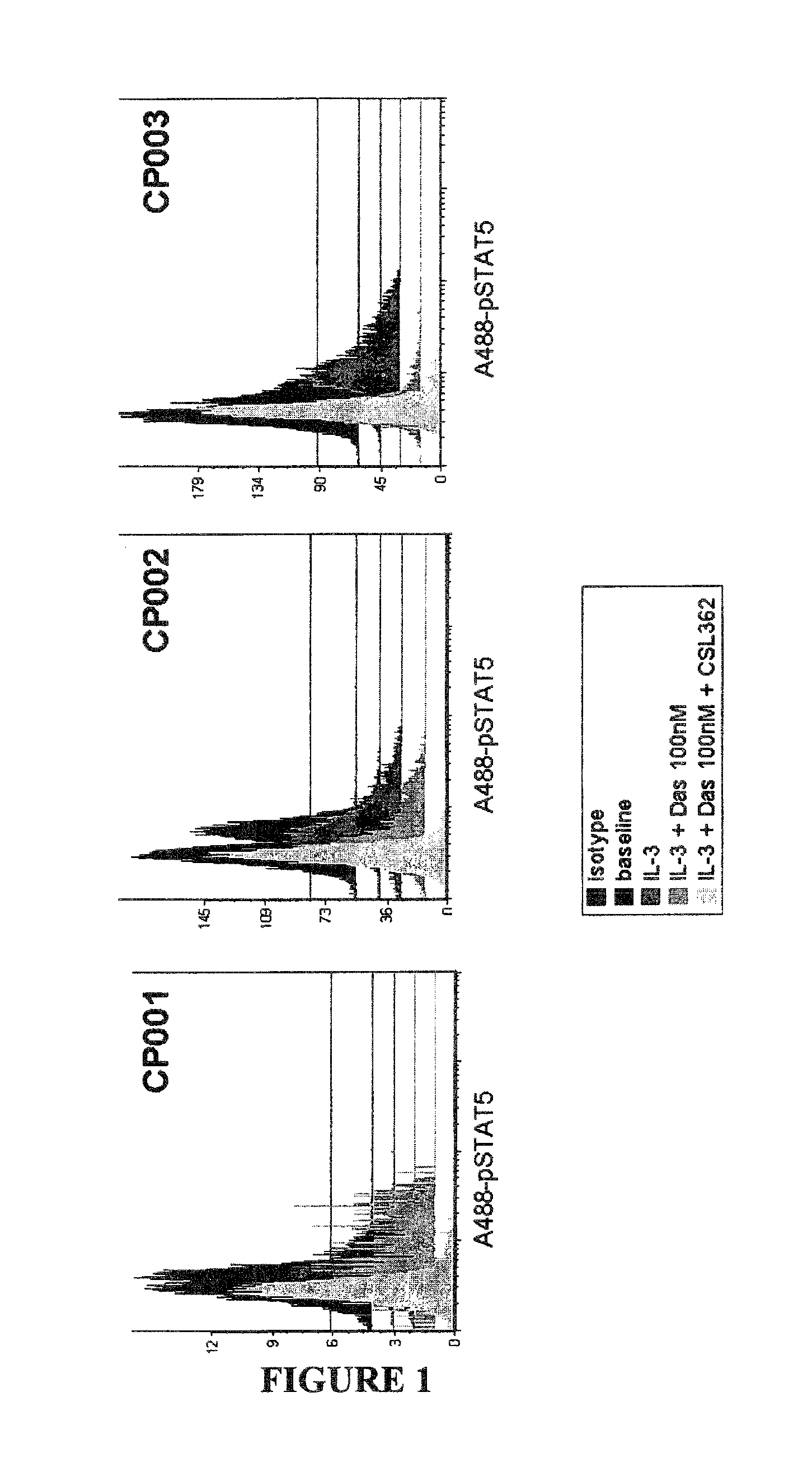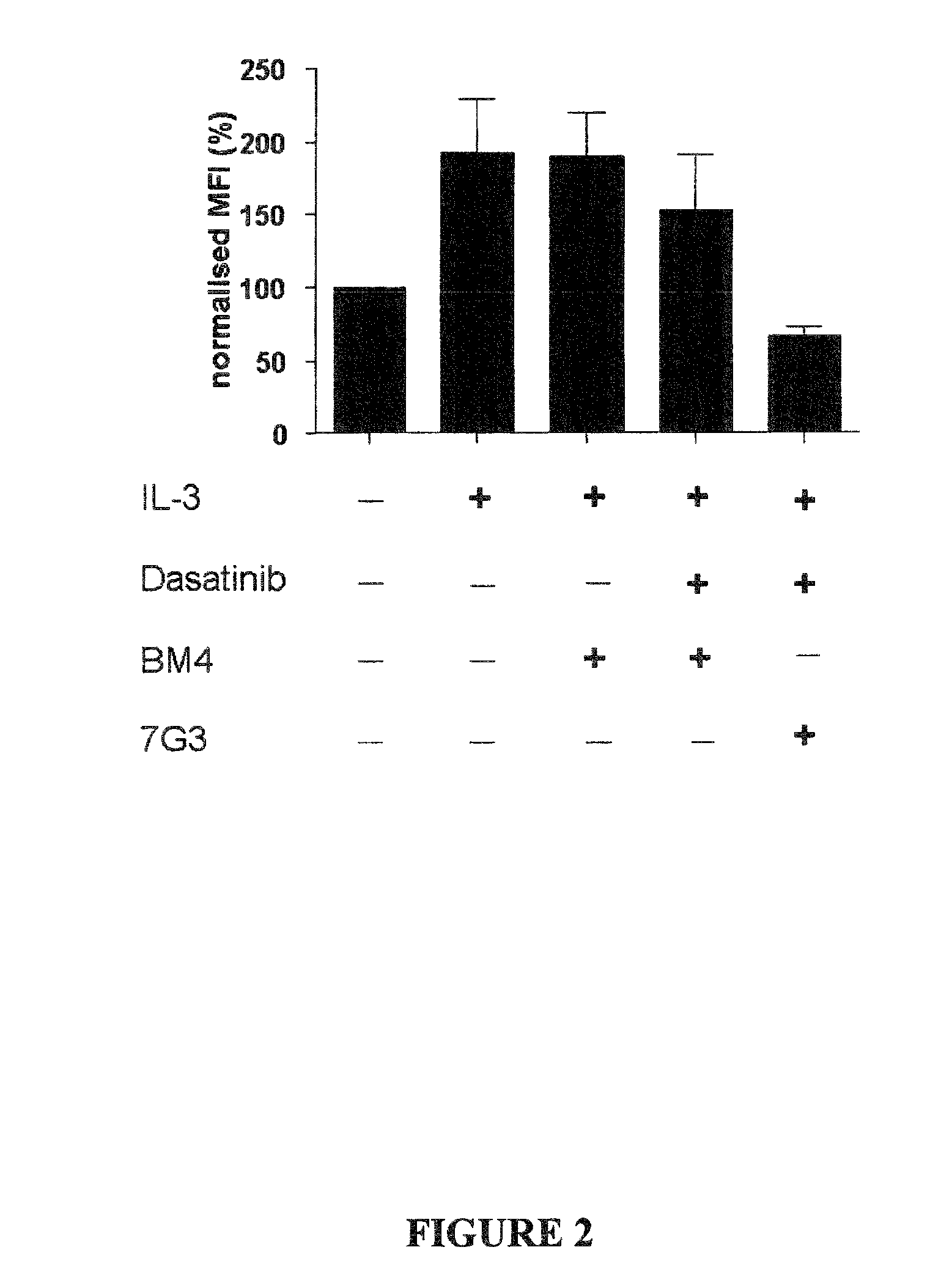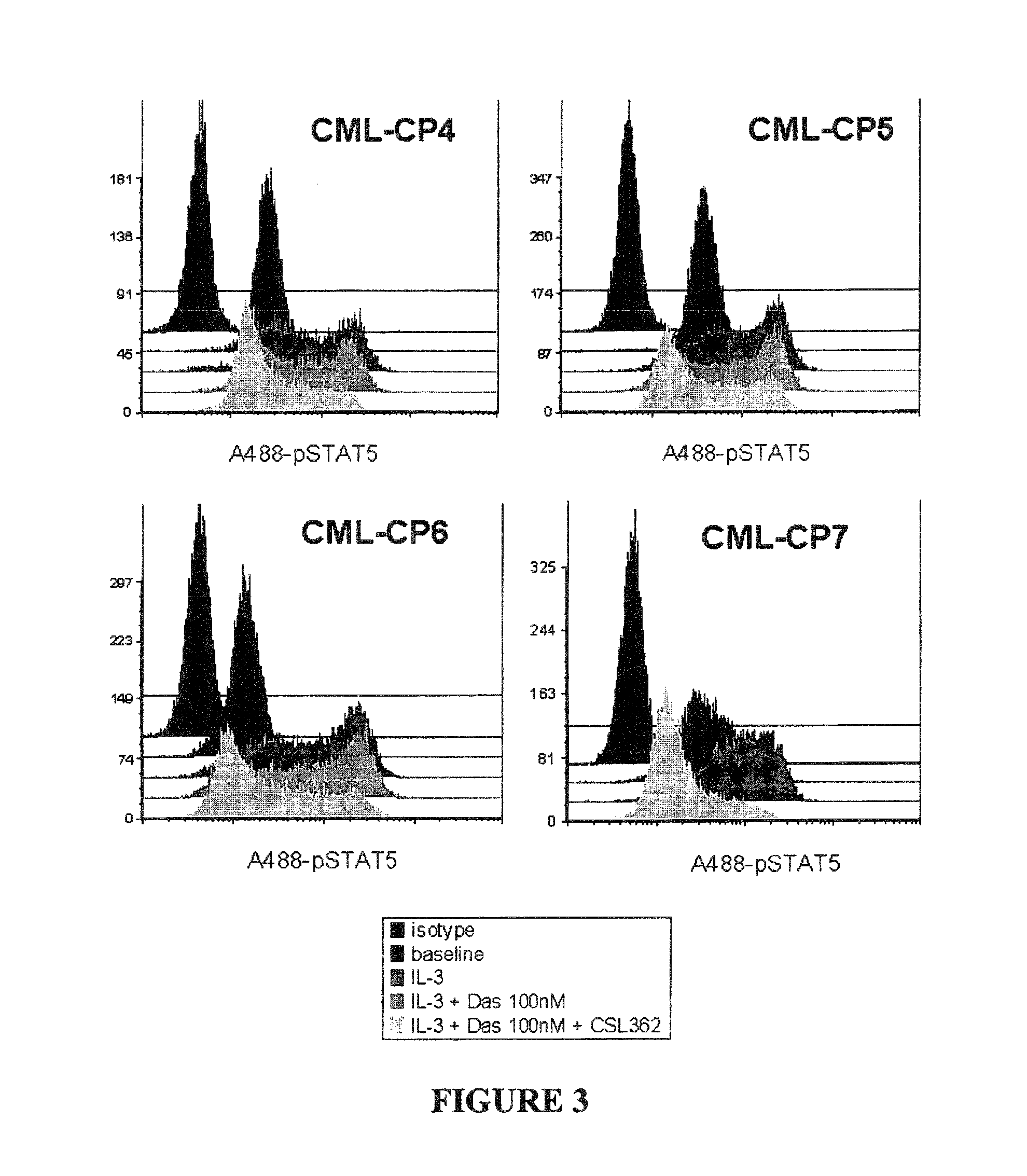Method of treatment of philadelphia chromosome positive leukaemia
a philadelphia chromosome and leukaemia technology, applied in the field of philadelphia chromosome positive (ph +) leukaemia treatment, can solve the problems of not all patients benefiting from imatinib and the frequency of curative effect of imatinib therapy
- Summary
- Abstract
- Description
- Claims
- Application Information
AI Technical Summary
Benefits of technology
Problems solved by technology
Method used
Image
Examples
example 1
Materials and Methods
CD34+ Cells
[0061]Mononuclear cells from blood collected from newly diagnosed CML-CP patients and normal donors were isolated by density gradient centrifugation using Lymphoprep (Axis-Shield, Norway). CD34-positive cells were further purified by magnetic-assisted cell sorting using CD34 mAb-coupled magnetic micro-beads (Miltenyi Biotech, Germany).
pSTAT5 assay (used to measure cytokine induced signalling)
[0062]CD34+ progenitor cells were cultured in serum-deprived media (SDM, containing IMDM, 2 mM L-glutamine, 1% BSA, 1 U / ml insulin, 0.2 mg / ml transferrin, 0.1 mM 2-mercaptoethanol and 20 μg / ml low-density lipoproteins). For examining STAT5 phosphorylation levels, cells were pre-treated with CSL362 or 7G3 (0.1 μg / ml) and / or Dasatinib (100 nM; Symansis, New Zealand) as indicated prior to stimulation with 20 ng / ml IL-3 (Pepro Tech, USA). Following PFA-fixation and permeabilisation with ice-cold methanol, cells were stained with Alexa488-conjugated pY694-STAT5 antibod...
example 2
[0065]This example shows that mAb 7G3 and dasatinib cooperate in attenuating IL-3 induced phosphorylation in CML patient primary CD34+ cell samples.
[0066]CD34+ cells from newly diagnosed CML-chronic phase (CML-CP) patients (n=3) were incubated with 100 nM Dasatinib, 7G3 (100 ng / ml) as indicated and consecutively stimulated with 20 ng / ml IL-3 for 10 min prior to PFA-fixation and methanol-permeabilisation. STAT5 phosphorylation was determined by flow cytometry using a Alexa488-conjugated pY694-STAT5 antibody (Phosflow, BD). (Baseline: represents the basal level of STAT5 phosphorylation in unstimulated cells); IL-3: p-STAT5 expression in cells cultured with 20 ng / ml IL-3; IL-3+Das 100 nM: p-STAT5 expression in cells cultured with 100 nM dasatinib and 20 ng / ml IL-3; IL-3+Das 100 nM+ 7G3: p-STAT5 expression in cells cultured with 100 nM dasatinib, 20 ng / ml IL-3 and 7G3 (110 ng / ml).
[0067]FIG. 1 and FIG. 2 (a graphical representation of the data presented in FIG. 1) show that in the presen...
example 3
[0068]This example shows that mAb CSL362 (a humanized and Fc effector enhanced variant of 7G3) and dasatinib cooperate in attenuating IL-3-induced STAT5 phosphorylation in CML patient primary CD34+ cell samples.
[0069]Freshly thawed CD34+ cells from newly diagnosed chronic phase CML patients after 1 h of recovery in SDM were incubated with 100 nM Dasatinib, 0.1 μg / ml CSL362 or BM4 (an isotype-matched control for CSL362) or CSL362 and Dasatinib as indicated and consecutively stimulated with 20 ng / ml IL-3 for 10 min prior to PFA-fixation and methanol-permeabilisation. STAT5 phosphorylation was determined by flow cytometry using a Alexa488-conjugated pY694-STAT5 antibody (Phosflow, BD). A488-pSTAT fluorescence histograms of individual patient samples are shown in FIG. 3 (cells only represents the unstimulated level of STAT5 phosphorylation in these cells). FIG. 4 is a graphical representation of the data presented in FIG. 3. Mean fluorescence intensity normalised to the baseline STAT5 p...
PUM
| Property | Measurement | Unit |
|---|---|---|
| time | aaaaa | aaaaa |
| time | aaaaa | aaaaa |
| volume | aaaaa | aaaaa |
Abstract
Description
Claims
Application Information
 Login to View More
Login to View More - R&D
- Intellectual Property
- Life Sciences
- Materials
- Tech Scout
- Unparalleled Data Quality
- Higher Quality Content
- 60% Fewer Hallucinations
Browse by: Latest US Patents, China's latest patents, Technical Efficacy Thesaurus, Application Domain, Technology Topic, Popular Technical Reports.
© 2025 PatSnap. All rights reserved.Legal|Privacy policy|Modern Slavery Act Transparency Statement|Sitemap|About US| Contact US: help@patsnap.com



